|
When it comes to watering house plants there are
basically three types of people - those who overwater, those who
underwater, and those who water just right, but most fall into the
overwaterer and underwaterer categories. Which one are you?
The fastest way to kill a house plant is by
overwatering, however there are a few plants that will die just as
fast if allowed to severely dry out. For house plant success, try to
match your watering personality with the appropriate plant. The
following are some good house plants for those who are more forgetful
waterers. Click on a plant name below to order it from Pernell
Gerver's Online Store.
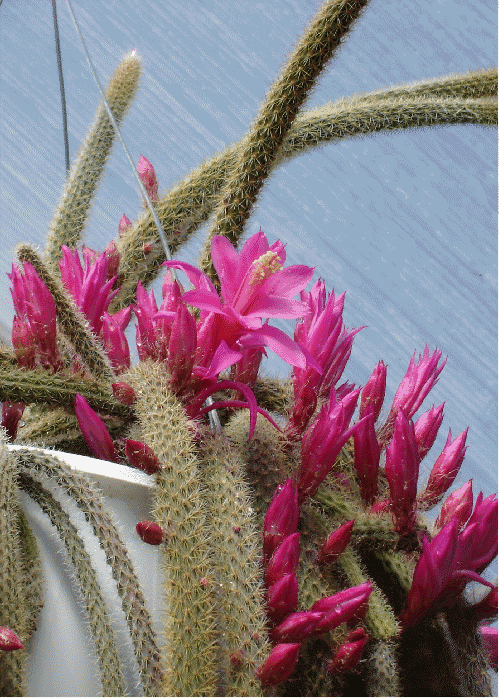 When
thinking of plants suitable for underwaterers, cacti and succulents
immediately come to mind. The stems of cactus are water storage
vessels that allow the plant to hold water and use it as needed. In
the desert, the cactus uses water stored in its stems to keep it
alive during periods of drought. During the short periods of
rainfall, the cactus replenishes its water reserves. While most
plants lose moisture through their leaves, cactus has no leaves, and
doesn't lose moisture this way. When grown indoors as a house plant,
cacti need infrequent watering. Water enough to thoroughly moisten
the soil, then allow the plant to completely dry out before watering
again. Never let a cactus sit in water. Rattail
cactus has long, slender, trailing stems that hang
gracefully downward. Soft, white spines line its gray-green stems. In
spring, its stems bear dozens and dozens of fuchsia-pink tubular
flowers that stand perpendicular to the stems. The flowers are up to
two inches long and are in bloom for weeks. When
thinking of plants suitable for underwaterers, cacti and succulents
immediately come to mind. The stems of cactus are water storage
vessels that allow the plant to hold water and use it as needed. In
the desert, the cactus uses water stored in its stems to keep it
alive during periods of drought. During the short periods of
rainfall, the cactus replenishes its water reserves. While most
plants lose moisture through their leaves, cactus has no leaves, and
doesn't lose moisture this way. When grown indoors as a house plant,
cacti need infrequent watering. Water enough to thoroughly moisten
the soil, then allow the plant to completely dry out before watering
again. Never let a cactus sit in water. Rattail
cactus has long, slender, trailing stems that hang
gracefully downward. Soft, white spines line its gray-green stems. In
spring, its stems bear dozens and dozens of fuchsia-pink tubular
flowers that stand perpendicular to the stems. The flowers are up to
two inches long and are in bloom for weeks. |
|
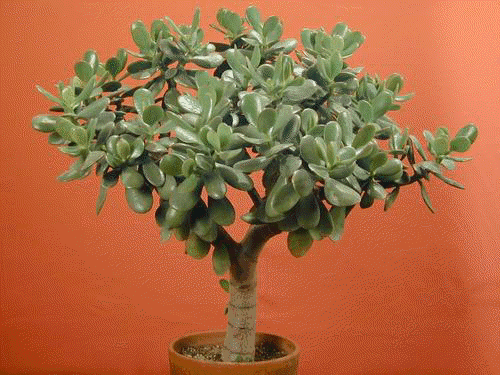 Succulent
house plants have thick, fleshy leaves that also store water like
cactus. Jade plant (Crassula argentea)
is a type of succulent house plant. It has thick, slightly-cupped,
green leaves on stout stems. Its overall shape resembles a small
tree. Mature plants sometimes produce flower clusters of white or
pink flowers in winter. Succulent
house plants have thick, fleshy leaves that also store water like
cactus. Jade plant (Crassula argentea)
is a type of succulent house plant. It has thick, slightly-cupped,
green leaves on stout stems. Its overall shape resembles a small
tree. Mature plants sometimes produce flower clusters of white or
pink flowers in winter.
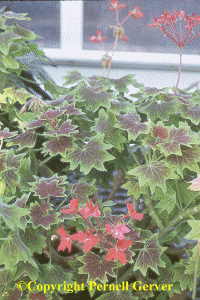 Geranium
(Pelargonium spp.) is commonly grown outdoors as a summer bedding
plant. It can also be grown indoors as a house plant. There are many
types of geraniums to grow indoors. Along with the common
bedding-plant-type geranium, there are also scented-leaved and
fancy-leaved types that do well as house plants. All prefer to dry
out between waterings and will rot off if watered too frequently.
Scented-leaved geraniums are grown for their aromatic foliage which
includes rose, mint, and apple, to mention a few. Fancy-leaved
geraniums have showy foliage along with their colorful flowers. Geranium
'Vancouver Centennial' is a fancy-leaved geranium that has
fan-shaped leaves that are marked with a blotch of deep maroon in the
center, leaving only a thin margin of chartreuse around the edges.
Star-shaped flowers are bright, scarlet orange with serrated edges.
It blooms year 'round. It's a wonderful house plant year 'round and a
great bedding plant for the summer garden, as well. Geranium
(Pelargonium spp.) is commonly grown outdoors as a summer bedding
plant. It can also be grown indoors as a house plant. There are many
types of geraniums to grow indoors. Along with the common
bedding-plant-type geranium, there are also scented-leaved and
fancy-leaved types that do well as house plants. All prefer to dry
out between waterings and will rot off if watered too frequently.
Scented-leaved geraniums are grown for their aromatic foliage which
includes rose, mint, and apple, to mention a few. Fancy-leaved
geraniums have showy foliage along with their colorful flowers. Geranium
'Vancouver Centennial' is a fancy-leaved geranium that has
fan-shaped leaves that are marked with a blotch of deep maroon in the
center, leaving only a thin margin of chartreuse around the edges.
Star-shaped flowers are bright, scarlet orange with serrated edges.
It blooms year 'round. It's a wonderful house plant year 'round and a
great bedding plant for the summer garden, as well.
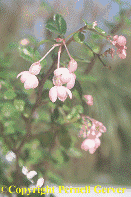 There
are many types of house plant begonias (Begonia spp.) with different
growing habits. Some are grown for their striking foliage, others for
their showy flowers. There are miniature types growing only several
inches tall, and others that grow six feet tall or more. Flower
shapes vary, from small, single flowers to large, fully-double types.
Flower colors include white, pink, orange, red, and bicolors. Begonia
fuchsiodes has small, one-inch foliage that is glossy green.
Its stems arch gracefully downward. Tiny pink flowers that resemble
fuchsia blooms dangle from the stems. Regardless of type, all
begonias prefer to dry out between waterings. Like geraniums,
begonias can rot off if overwatered. There
are many types of house plant begonias (Begonia spp.) with different
growing habits. Some are grown for their striking foliage, others for
their showy flowers. There are miniature types growing only several
inches tall, and others that grow six feet tall or more. Flower
shapes vary, from small, single flowers to large, fully-double types.
Flower colors include white, pink, orange, red, and bicolors. Begonia
fuchsiodes has small, one-inch foliage that is glossy green.
Its stems arch gracefully downward. Tiny pink flowers that resemble
fuchsia blooms dangle from the stems. Regardless of type, all
begonias prefer to dry out between waterings. Like geraniums,
begonias can rot off if overwatered.
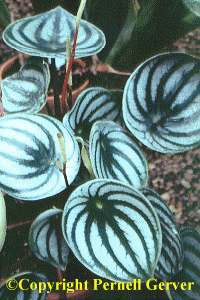 Peperomia
(Peperomia spp.) is another house plant for underwaterers.
Overwatering this plant nearly always leads to its demise. Its thick,
fleshy leaves allow it to withstand considerable dryness. Most types
of peperomia have oval or heart-shaped leaves. Watermelon
peperomia (Peperomia argyreia) is aptly named. It has
distinct, silver stripes running from the top of its oval leaf
downward, giving it the appearance of a watermelon rind. Peperomia
flowers are unusual. Each is a skinny spike, up to 10 inches tall. It
rises up through the clump of foliage and is usually white or cream. Peperomia
(Peperomia spp.) is another house plant for underwaterers.
Overwatering this plant nearly always leads to its demise. Its thick,
fleshy leaves allow it to withstand considerable dryness. Most types
of peperomia have oval or heart-shaped leaves. Watermelon
peperomia (Peperomia argyreia) is aptly named. It has
distinct, silver stripes running from the top of its oval leaf
downward, giving it the appearance of a watermelon rind. Peperomia
flowers are unusual. Each is a skinny spike, up to 10 inches tall. It
rises up through the clump of foliage and is usually white or cream.
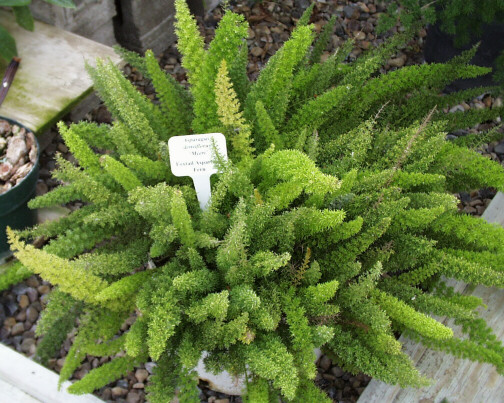 Foxtail
fern (Asparagus myersii) is a house plant with an
interesting form. It has foxtail-shaped fronds with bright green
needles. This is a good plant to use outdoors in summer as an accent
plant in container gardens. As a house plant, foxtail fern has fronds
nearly a foot and a half long and two to three inches across. Each
frond tapers to a point. The fronds arch slightly downward from the
center of the plant. Foxtail fern is a clump-forming plant and is
very graceful plant in its appearance. Easily reaching several feet
across, a mature plant makes a bold statement. In summer, it bears
small white flowers followed by bright red berries. Foxtail fern
grows from a tuberous root. Swollen, white, water-holding nodes are
produced along the roots. These store and release water as needed
during dry periods. Foxtail
fern (Asparagus myersii) is a house plant with an
interesting form. It has foxtail-shaped fronds with bright green
needles. This is a good plant to use outdoors in summer as an accent
plant in container gardens. As a house plant, foxtail fern has fronds
nearly a foot and a half long and two to three inches across. Each
frond tapers to a point. The fronds arch slightly downward from the
center of the plant. Foxtail fern is a clump-forming plant and is
very graceful plant in its appearance. Easily reaching several feet
across, a mature plant makes a bold statement. In summer, it bears
small white flowers followed by bright red berries. Foxtail fern
grows from a tuberous root. Swollen, white, water-holding nodes are
produced along the roots. These store and release water as needed
during dry periods. |



 When
thinking of plants suitable for underwaterers, cacti and succulents
immediately come to mind. The stems of cactus are water storage
vessels that allow the plant to hold water and use it as needed. In
the desert, the cactus uses water stored in its stems to keep it
alive during periods of drought. During the short periods of
rainfall, the cactus replenishes its water reserves. While most
plants lose moisture through their leaves, cactus has no leaves, and
doesn't lose moisture this way. When grown indoors as a house plant,
cacti need infrequent watering. Water enough to thoroughly moisten
the soil, then allow the plant to completely dry out before watering
again. Never let a cactus sit in water.
When
thinking of plants suitable for underwaterers, cacti and succulents
immediately come to mind. The stems of cactus are water storage
vessels that allow the plant to hold water and use it as needed. In
the desert, the cactus uses water stored in its stems to keep it
alive during periods of drought. During the short periods of
rainfall, the cactus replenishes its water reserves. While most
plants lose moisture through their leaves, cactus has no leaves, and
doesn't lose moisture this way. When grown indoors as a house plant,
cacti need infrequent watering. Water enough to thoroughly moisten
the soil, then allow the plant to completely dry out before watering
again. Never let a cactus sit in water.  Succulent
house plants have thick, fleshy leaves that also store water like
cactus.
Succulent
house plants have thick, fleshy leaves that also store water like
cactus.  Geranium
(Pelargonium spp.) is commonly grown outdoors as a summer bedding
plant. It can also be grown indoors as a house plant. There are many
types of geraniums to grow indoors. Along with the common
bedding-plant-type geranium, there are also scented-leaved and
fancy-leaved types that do well as house plants. All prefer to dry
out between waterings and will rot off if watered too frequently.
Scented-leaved geraniums are grown for their aromatic foliage which
includes rose, mint, and apple, to mention a few. Fancy-leaved
geraniums have showy foliage along with their colorful flowers.
Geranium
(Pelargonium spp.) is commonly grown outdoors as a summer bedding
plant. It can also be grown indoors as a house plant. There are many
types of geraniums to grow indoors. Along with the common
bedding-plant-type geranium, there are also scented-leaved and
fancy-leaved types that do well as house plants. All prefer to dry
out between waterings and will rot off if watered too frequently.
Scented-leaved geraniums are grown for their aromatic foliage which
includes rose, mint, and apple, to mention a few. Fancy-leaved
geraniums have showy foliage along with their colorful flowers.  There
are many types of house plant begonias (Begonia spp.) with different
growing habits. Some are grown for their striking foliage, others for
their showy flowers. There are miniature types growing only several
inches tall, and others that grow six feet tall or more. Flower
shapes vary, from small, single flowers to large, fully-double types.
Flower colors include white, pink, orange, red, and bicolors.
There
are many types of house plant begonias (Begonia spp.) with different
growing habits. Some are grown for their striking foliage, others for
their showy flowers. There are miniature types growing only several
inches tall, and others that grow six feet tall or more. Flower
shapes vary, from small, single flowers to large, fully-double types.
Flower colors include white, pink, orange, red, and bicolors.  Peperomia
(Peperomia spp.) is another house plant for underwaterers.
Overwatering this plant nearly always leads to its demise. Its thick,
fleshy leaves allow it to withstand considerable dryness. Most types
of peperomia have oval or heart-shaped leaves.
Peperomia
(Peperomia spp.) is another house plant for underwaterers.
Overwatering this plant nearly always leads to its demise. Its thick,
fleshy leaves allow it to withstand considerable dryness. Most types
of peperomia have oval or heart-shaped leaves. 
 by
Pernell Gerver
by
Pernell Gerver A.
A.